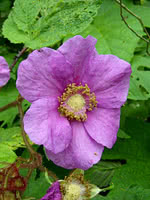Mon-Fri 9am - 5pm Mountain time
Black Locust vs Flowering Raspberry
Robinia pseudoacacia
Rubus odoratus
NOT AVAILABLE THIS SEASON - MIGHT RETURN
Black Locust is an attractive tree. Its distinctive leaves are made of about a dozen bright green leaflets. It also notable for its fragrant white flowers, which smell of citrus.
Black Locust can grow in many situations, but prefers dry areas with lots of sun. It is robust and is an excellent choice for establishing shade in dry, open areas.
Important note: Much of the Black Locust is toxic to humans and livestock, including seeds, bark, and leaves.
The Flowering Raspberry is an ornamental shrubby plant that blooms with fragrant light purple flowers throughout the summer and has a large, decorative foliage of bright green leaves. The flowers resemble that of a wildrose, and the foliage turns a bright yellow in the fall. This cultivar produces small red raspberries, similar to that of a thimbleberry, but the fruit is mostly tasteless.
The Flowering Raspberry, also known as Virginia Raspberry or Purple-Flowered Raspberry, makes a great hedge plant and is a good choice for attracting birds to your yard.

